(完整)初中英语一般现在时
(完整)英语8种时态
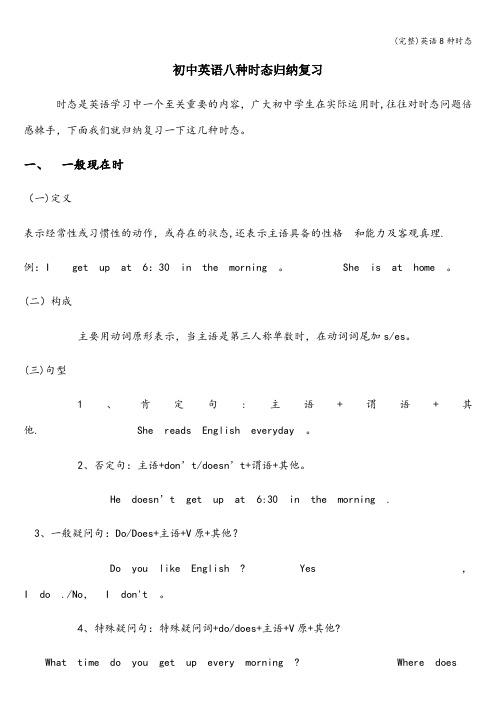
初中英语八种时态归纳复习时态是英语学习中一个至关重要的内容,广大初中学生在实际运用时,往往对时态问题倍感棘手,下面我们就归纳复习一下这几种时态。
一、一般现在时(一)定义表示经常性或习惯性的动作,或存在的状态,还表示主语具备的性格和能力及客观真理. 例:I get up at 6:30 in the morning 。
She is at home 。
(二)构成主要用动词原形表示,当主语是第三人称单数时,在动词词尾加s/es。
(三)句型1、肯定句:主语+谓语+其他. She reads English everyday 。
2、否定句:主语+don’t/doesn’t+谓语+其他。
He doesn’t get up at 6:30 in the morning .3、一般疑问句:Do/Does+主语+V原+其他?Do you like English ? Yes ,I do ./No,I don't 。
4、特殊疑问句:特殊疑问词+do/does+主语+V原+其他?What time do you get up every morning ? Where doesyour father work ?(三)用法1、表示经常性或习惯性的动作,或存在的状态,带与表示频率的时间状语如:often ,sometimes , usually,always , everyday year,month...), once/twice a week (month , year ,etc。
), seldom , on Sundays等连用。
I leave home for school at seven every morning 。
2、表示客观真理,科学事实、格言警句.The sun rises in the east .日出东方。
The earth goes around the sun .地球绕着太阳转。
Ten minus two is eight。
(完整)初中英语六大时态

六大英语时态一、一般现在时:(1)经常性、习惯性的动作或存在的状态Eg: I go to school on foot.(2) 主语的特征、性格、能力、爱好等Eg: I like watching TV.(3) 客观真理Eg: The moon moves round the earth.其结构按正常语序,即“主语+谓语+其他”。
有时为了起强调作用,时间状语也可提前。
一般现在时的句式变化可分为两种情况:○1一般人称做主语,表示动作变否定句时,须在动词前加助动词don’t;变一般疑问句时,须在句首加助动词do.Eg: 肯定句They have lunch at 12. 否定句:They don’t have lunch at 12. 一般疑问句: Do they have lunch at 12.○2第三人称单数作主语,谓语动词变单三;变否定句时,须在动词前加助动词doesn’t; 变一般疑问句时,须在句首加助动词does Eg: He does morning exercises.→He doesn’t do morning exercises.→Does he often go to school on foot?一般现在时的时间状语有on Saturdays, in the morning(afternoon, evening),every day, at weekend, how often及一些频率副词often, usually, always, sometimes, seldom, never 等。
动词变单三规则1. 一般情况下,在动词后直接加-s Eg: works, gets, says, reads2. 以s, x, sh, ch, o结尾,加-es Eg: goes, teaches, washes, does3. 以“辅音+y” 结尾,变y为i,再加-es Eg: fly-flies, study-studies4. 不规则变化have-has二、一般过去时:表示过去某时发生的动作或情况(1)过去某个时间所发生的动作或存在的状态Eg: He was a worker two years ago.(2) 过去一段时间内,经常性或习惯性的动作Eg: When I was a student, I often played with my classmates.(3)谈到已故人的情况时多用过去时Eg: Lu Xun was a great writer.(4) 有些发生时间不是很清楚(未明确表述)的情况,实际是过去发生的,也应用过去时态Eg: What did you say?一般过去时的结构是“主语+动词的过去式”。
初中英语教材中的一般现在时态

初中英语教材中的一般现在时态一般现在时是英语中最基础的一种时态,用来表示现在的动作、习惯或客观事实。
在初中英语教材中,一般现在时态是学生首次接触的时态之一,是他们学习英语的基础。
以下是一般现在时态的中文解释,包括基本用法、构成和一些例句。
一、基本用法一般现在时表示习惯性的动作、经常发生的动作、客观事实等。
常用的时间状语有:always(总是)、often(经常)、usually(通常)、sometimes(有时候)、every day/week (每天/星期)、in the morning/afternoon/evening(在早晨/下午/晚上)、at night(在夜晚)等。
二、构成1. 肯定句主语 + 动词原形(第三人称单数要加-s)+其他成分例如:She plays basketball every day.(她每天打篮球。
)2. 否定句主语 + 动词原形(第三人称单数要加-s)+ not +其他成分例如:He does not like coffee.(他不喜欢咖啡。
)3. 疑问句助动词do/does +主语+动词原形+其他成分例如:Do they go to school by bus?(他们乘公共汽车上学吗?)特殊疑问词+ 助动词do/does+主语+动词原形+其他成分例如:What does your father do?(你父亲是做什么工作的?)三、例句1. My sister always helps me with my homework.(我姐姐总是帮助我做作业。
)2. They often play football after school.(他们放学后经常踢足球。
)3. My mother usually cooks dinner for our family.(我妈妈通常为我们家做晚饭。
)4. Tom sometimes visits his grandparents on weekends.(汤姆有时候在周末去看望他的祖父母。
(完整word版)人教版英语初一语法一般现在时
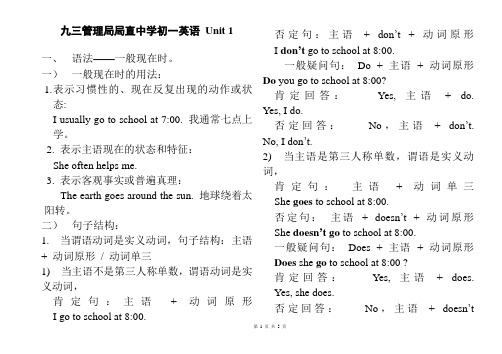
九三管理局局直中学初一英语Unit 1一、语法——一般现在时。
一)一般现在时的用法:1.表示习惯性的、现在反复出现的动作或状态:I usually go to school at 7:00. 我通常七点上学。
2. 表示主语现在的状态和特征:She often helps me.3. 表示客观事实或普遍真理:The earth goes around the sun. 地球绕着太阳转。
二)句子结构:1. 当谓语动词是实义动词,句子结构:主语+ 动词原形/ 动词单三1) 当主语不是第三人称单数,谓语动词是实义动词,肯定句:主语+ 动词原形I go to school at 8:00.否定句:主语+ don’t+ 动词原形I don’t go to school at 8:00.一般疑问句:Do + 主语+ 动词原形Do you go to school at 8:00?肯定回答:Yes, 主语+ do. Yes, I do.否定回答:No,主语+ don’t. No, I don’t.2) 当主语是第三人称单数,谓语是实义动词,肯定句:主语+ 动词单三She goes to school at 8:00.否定句:主语+ doesn’t + 动词原形She doesn’t go to school at 8:00.一般疑问句:Does + 主语+ 动词原形Does she go to school at 8:00 ?肯定回答:Yes, 主语+ does.Yes, she does.否定回答:No,主语+ doesn’tNo, she doesn’t.3)动词第三人称单数的变化规则:a. 一般情况下,在词尾加-s:play- plays get- gets.b. 以s,x,sh,ch结尾的动词,在词尾加-es:watch- watches go- goes.c. 以辅音字母加y结尾的动词,要把y变成i,再加-es:fly- flies study- studies2. 当谓语动词是be动词,句子结构:主语+ be 的适当形式1) 肯定句:主语+ be (am / is are)I am an English teacher.否定句:主语+ be (m / is are)+ notI am not an English teacher.一般疑问句:Be(Is/ Are) + 主语Are you an English teacher?肯定回答:Yes, 主语+ be(am/ is/ are). Yes, I am.否定回答:No,主语+ don’t. No, I am not.2)be动词的使用口诀:我用am,你用are,is连着他她塔,单数is 复数are。
初中英语知识点归纳一般现在时的构成与用法
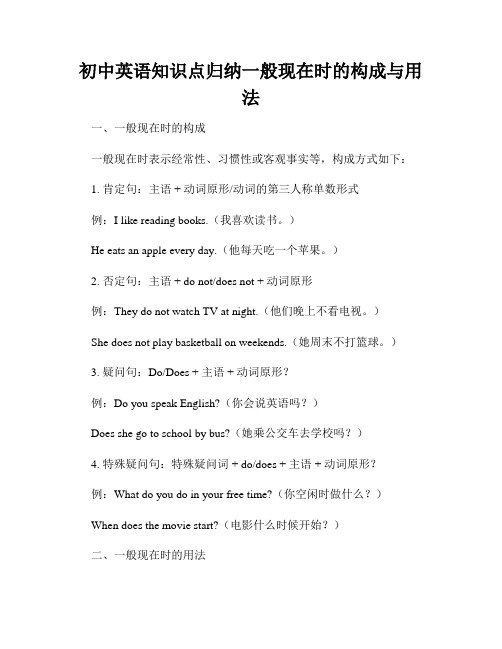
初中英语知识点归纳一般现在时的构成与用法一、一般现在时的构成一般现在时表示经常性、习惯性或客观事实等,构成方式如下:1. 肯定句:主语 + 动词原形/动词的第三人称单数形式例:I like reading books.(我喜欢读书。
)He eats an apple every day.(他每天吃一个苹果。
)2. 否定句:主语 + do not/does not + 动词原形例:They do not watch TV at night.(他们晚上不看电视。
)She does not play basketball on weekends.(她周末不打篮球。
)3. 疑问句:Do/Does + 主语 + 动词原形?例:Do you speak English?(你会说英语吗?)Does she go to school by bus?(她乘公交车去学校吗?)4. 特殊疑问句:特殊疑问词 + do/does + 主语 + 动词原形?例:What do you do in your free time?(你空闲时做什么?)When does the movie start?(电影什么时候开始?)二、一般现在时的用法一般现在时用于以下几种情况:1. 表示经常性或习惯性的动作或状态。
例:My mother often cooks dinner for us.(我妈妈经常给我们做晚饭。
)We usually go to the park on weekends.(我们通常在周末去公园。
)2. 表示客观事实、自然规律或科学真理。
例:The sun rises in the east.(太阳从东方升起。
)Water boils at 100 degrees Celsius.(水在100摄氏度沸腾。
)3. 表示现有状况或个人特征。
例:I have two cats.(我有两只猫。
)She lives in London.(她住在伦敦。
(完整)一般现在时讲解与练习(初中英语)
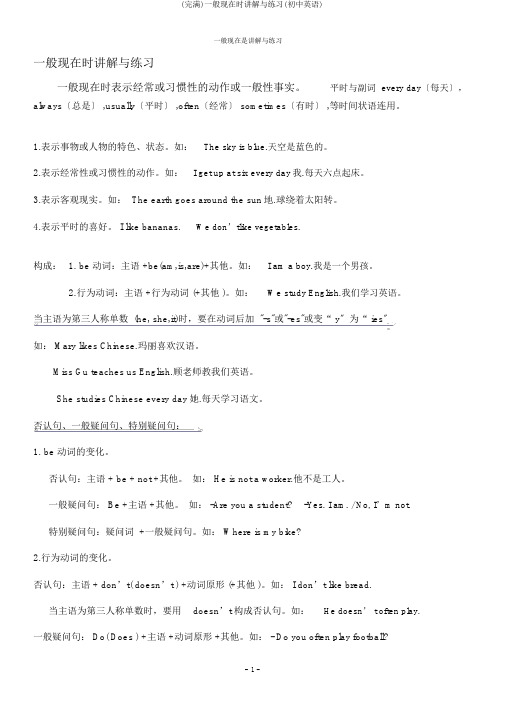
一般现在是讲解与练习一般现在时讲解与练习一般现在时表示经常或习惯性的动作或一般性事实。
平时与副词 every day〔每天〕,always〔总是〕 ,usually〔平时〕 ,often〔经常〕 sometimes〔有时〕 ,等时间状语连用。
1.表示事物或人物的特色、状态。
如:The sky is blue.天空是蓝色的。
2.表示经常性或习惯性的动作。
如:I get up at six every day我.每天六点起床。
3.表示客观现实。
如: The earth goes around the sun地.球绕着太阳转。
4.表示平时的喜好。
I like bananas.We don’tlike vegetables.构成: 1. be 动词:主语 +be(am,is,are)+其他。
如:I am a boy.我是一个男孩。
2.行为动词:主语 +行为动词 (+其他 )。
如:We study English.我们学习英语。
当主语为第三人称单数 (he, she,it)时,要在动词后加 "-s"或"-es"或变“ y〞为“ ies〞如: Mary likes Chinese.玛丽喜欢汉语。
Miss Gu teaches us English.顾老师教我们英语。
She studies Chinese every day她.每天学习语文。
否认句、一般疑问句、特别疑问句:1. be 动词的变化。
否认句:主语 + be + not +其他。
如: He is not a worker.他不是工人。
一般疑问句: Be +主语 +其他。
如: -Are you a student?-Yes. I am. / No, I’m not.特别疑问句:疑问词 +一般疑问句。
如: Where is my bike?2.行为动词的变化。
否认句:主语 + don’t( doesn’t ) +动词原形 (+其他 )。
初中一般现在时讲解
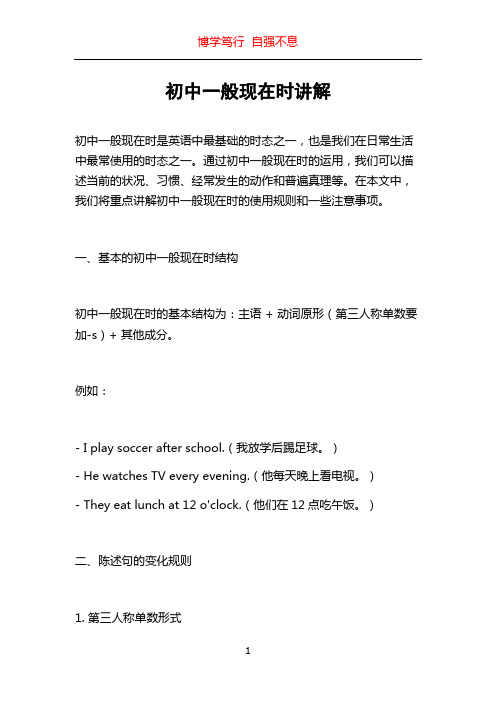
初中一般现在时讲解初中一般现在时是英语中最基础的时态之一,也是我们在日常生活中最常使用的时态之一。
通过初中一般现在时的运用,我们可以描述当前的状况、习惯、经常发生的动作和普遍真理等。
在本文中,我们将重点讲解初中一般现在时的使用规则和一些注意事项。
一、基本的初中一般现在时结构初中一般现在时的基本结构为:主语 + 动词原形(第三人称单数要加-s)+ 其他成分。
例如:- I play soccer after school.(我放学后踢足球。
)- He watches TV every evening.(他每天晚上看电视。
)- They eat lunch at 12 o'clock.(他们在12点吃午饭。
)二、陈述句的变化规则1. 第三人称单数形式在初中一般现在时中,第三人称单数(he、she、it或名词单数)的动词要变为原形加上-s。
例如:- She sings very well.(她唱得很好。
)- He plays basketball with his friends.(他和他的朋友们一起打篮球。
)- The dog barks loudly at strangers.(这条狗对陌生人叫得很大声。
)2. 不可数名词和复数名词与不可数名词一起使用时,动词保持原形。
与复数名词一起使用时,动词也保持原形。
例如:- The water tastes good.(水的味道很好。
)- The boys play soccer every Saturday.(这些男孩每个星期六踢足球。
)3. 特殊的第三人称单数形式以s、x、ch、sh和o结尾的名词通常在第三人称单数形式中加-es。
例如:- The bus goes to the city center.(这辆公交车开往市中心。
)- A box of candies is on the table.(桌子上有一盒糖果。
)- She brushes her teeth after meals.(她餐后刷牙。
初中英语语法八大时态总结(完整版)
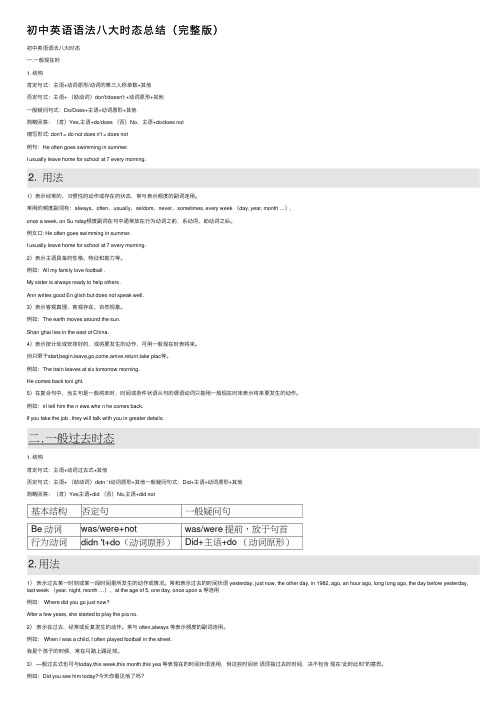
初中英语语法⼋⼤时态总结(完整版)初中英语语法⼋⼤时态⼀.⼀般现在时1. 结构肯定句式:主语+动词原形/动词的第三⼈称单数+其他否定句式:主语+ (助动词)don't/doesn't +动词原形+其他⼀般疑问句式:Do/Does+主语+动词原形+其他简略回答:(肯)Yes,主语+do/does (否)No,主语+do/does not缩写形式: don't = do not does n't = does not例句:He often goes swimming in summer.I usually leave home for school at 7 every morning.1)表⽰经常的、习惯性的动作或存在的状态,常与表⽰频度的副词连⽤。
常⽤的频度副词有:always、often、usually、seldom、never、sometimes, every week (day, year, month …),once a week, on Su nday频度副词在句中通常放在⾏为动词之前,系动词、助动词之后。
例⼥⼝: He often goes swimming in summer.I usually leave home for school at 7 every morning.2)表⽰主语具备的性格、特征和能⼒等。
例如:All my family love football .My sister is always ready to help others .Ann writes good En glish but does not speak well.3)表⽰客观真理、客观存在、⾃然现象。
例如:The earth moves around the sun.Shan ghai lies in the east of China.4)表⽰按计划或安排好的,或将要发⽣的动作,可⽤⼀般现在时表将来。
初中英语知识点时态总结
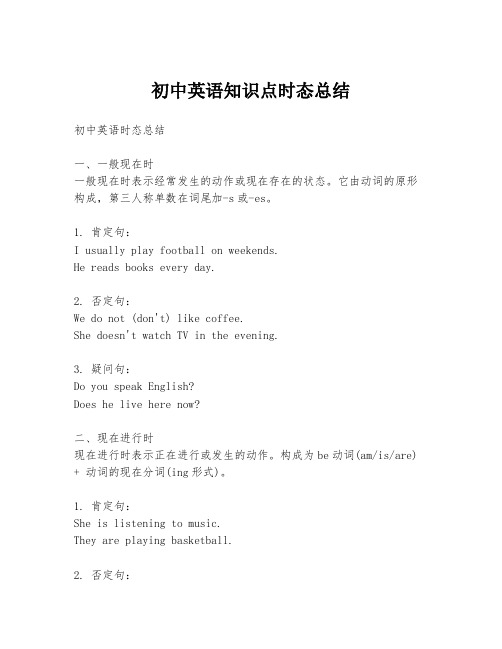
初中英语知识点时态总结初中英语时态总结一、一般现在时一般现在时表示经常发生的动作或现在存在的状态。
它由动词的原形构成,第三人称单数在词尾加-s或-es。
1. 肯定句:I usually play football on weekends.He reads books every day.2. 否定句:We do not (don't) like coffee.She doesn't watch TV in the evening.3. 疑问句:Do you speak English?Does he live here now?二、现在进行时现在进行时表示正在进行或发生的动作。
构成为be动词(am/is/are) + 动词的现在分词(ing形式)。
1. 肯定句:She is listening to music.They are playing basketball.2. 否定句:I am not (aren't) studying right now.The children are not (aren't) doing their homework.3. 疑问句:Is she cooking dinner?Are you waiting for someone?三、一般过去时一般过去时表示过去某个时间发生的动作或存在的状态。
规则动词在词尾加-ed,不规则动词则有特殊形式。
1. 肯定句:He walked to school yesterday.I visited my grandparents last week.2. 否定句:We did not (didn't) go to the cinema.She didn't buy anything at the store.3. 疑问句:Did you travel abroad last year?Did he finish his homework?四、过去进行时过去进行时表示过去某个时间点正在进行的动作。
初中英语语法知识之一般现在时
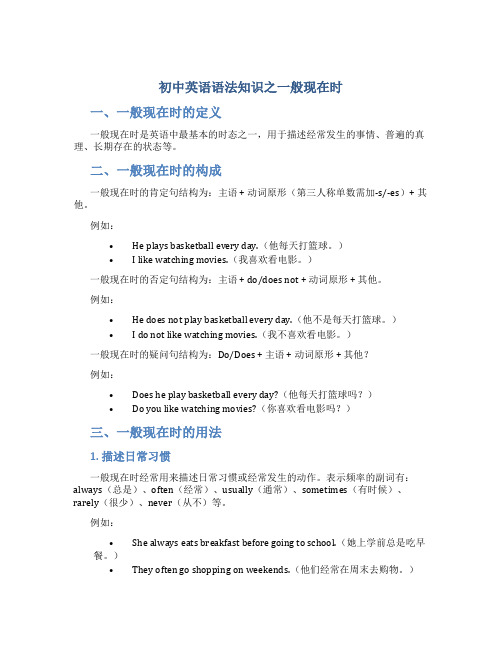
初中英语语法知识之一般现在时一、一般现在时的定义一般现在时是英语中最基本的时态之一,用于描述经常发生的事情、普遍的真理、长期存在的状态等。
二、一般现在时的构成一般现在时的肯定句结构为:主语 + 动词原形(第三人称单数需加-s/-es)+ 其他。
例如:•He plays basketball every day.(他每天打篮球。
)•I like watching movies.(我喜欢看电影。
)一般现在时的否定句结构为:主语 + do/does not + 动词原形 + 其他。
例如:•He does not play basketball every day.(他不是每天打篮球。
)•I do not like watching movies.(我不喜欢看电影。
)一般现在时的疑问句结构为:Do/Does + 主语 + 动词原形 + 其他?例如:•Does he play basketball every day?(他每天打篮球吗?)•Do you like watching movies?(你喜欢看电影吗?)三、一般现在时的用法1. 描述日常习惯一般现在时经常用来描述日常习惯或经常发生的动作。
表示频率的副词有:always(总是)、often(经常)、usually(通常)、sometimes(有时候)、rarely(很少)、never(从不)等。
例如:•She always eats breakfast before going to school.(她上学前总是吃早餐。
)•They often go shopping on weekends.(他们经常在周末去购物。
)2. 表达客观事实或普遍真理一般现在时也被用来表达客观事实或普遍真理。
例如:•The Earth revolves around the sun.(地球绕太阳运行。
)•Water boils at 100 degrees Celsius.(水在100摄氏度沸腾。
初中英语语法总结一般现在时
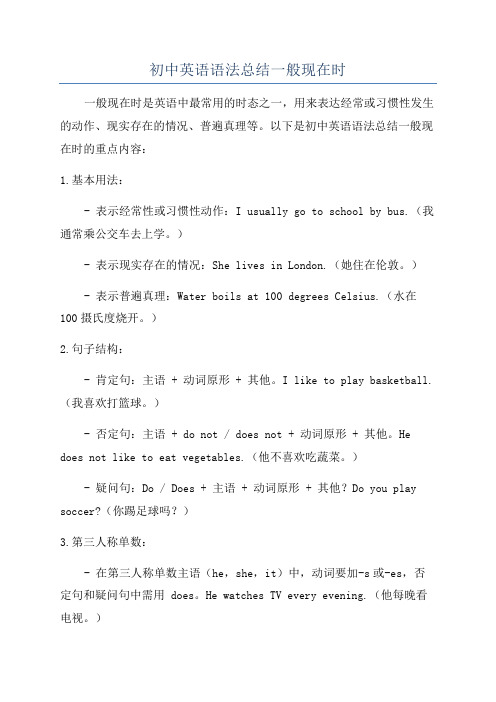
初中英语语法总结一般现在时一般现在时是英语中最常用的时态之一,用来表达经常或习惯性发生的动作、现实存在的情况、普遍真理等。
以下是初中英语语法总结一般现在时的重点内容:1.基本用法:- 表示经常性或习惯性动作:I usually go to school by bus.(我通常乘公交车去上学。
)- 表示现实存在的情况:She lives in London.(她住在伦敦。
)- 表示普遍真理:Water boils at 100 degrees Celsius.(水在100摄氏度烧开。
)2.句子结构:- 肯定句:主语 + 动词原形 + 其他。
I like to play basketball.(我喜欢打篮球。
)- 否定句:主语 + do not / does not + 动词原形 + 其他。
He does not like to eat vegetables.(他不喜欢吃蔬菜。
)- 疑问句:Do / Does + 主语 + 动词原形 + 其他?Do you play soccer?(你踢足球吗?)3.第三人称单数:- 在第三人称单数主语(he,she,it)中,动词要加-s或-es,否定句和疑问句中需用 does。
He watches TV every evening.(他每晚看电视。
)- 一些以s, sh, ch, x, o结尾的单词,需要在动词后加-es,如:misses,washes,watches。
4.频率副词:- 频率副词通常放在动词之前,用于修饰动词。
例如:She always helps others.(她总是帮助别人。
)5.现在进行时与一般现在时的区别:- 现在进行时表示现在正在发生的动作,一般与现在时间状语连用,或表示现阶段的临时情况。
例如:I am studying for the exam.(我正在准备考试。
- 一般现在时表示经常性、习惯性的动作或客观存在的状态。
例如:I usually play soccer on weekends.(我通常在周末踢足球。
初中英语知识点总结一般现在时
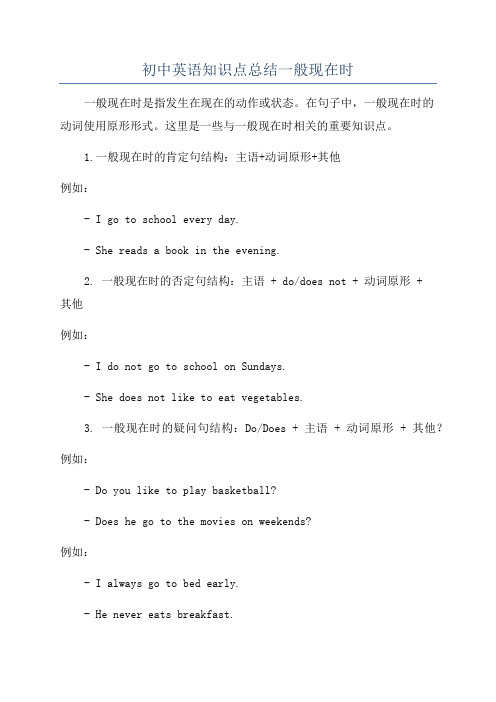
初中英语知识点总结一般现在时一般现在时是指发生在现在的动作或状态。
在句子中,一般现在时的动词使用原形形式。
这里是一些与一般现在时相关的重要知识点。
1.一般现在时的肯定句结构:主语+动词原形+其他例如:- I go to school every day.- She reads a book in the evening.2. 一般现在时的否定句结构:主语 + do/does not + 动词原形 +其他例如:- I do not go to school on Sundays.- She does not like to eat vegetables.3. 一般现在时的疑问句结构:Do/Does + 主语 + 动词原形 + 其他?例如:- Do you like to play basketball?- Does he go to the movies on weekends?例如:- I always go to bed early.- He never eats breakfast.5. 表示客观真理、规律或常识时,一般现在时可用于所有人称,不需要使用助动词do/does。
例如:- The sun rises in the east.- Water boils at 100 degrees Celsius.6. 当主语为第三人称单数时,动词需要变化。
一般情况下,加上-s 或-es。
例如:- She eats lunch at 12 o'clock.- The dog barks loudly.7.部分动词在第三人称单数时需要做变化- go→goes- do→does- have→has例如:- He goes to school by bus.- She does her homework every day.- My mother has a pet cat.8. 当主语为we, they, you或复数名词时,动词不需要做变化。
(完整)初中英语一般现在时
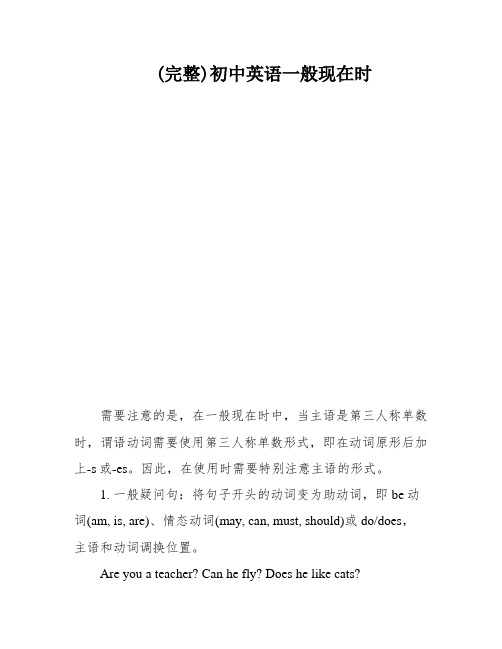
(完整)初中英语一般现在时需要注意的是,在一般现在时中,当主语是第三人称单数时,谓语动词需要使用第三人称单数形式,即在动词原形后加上-s或-es。
因此,在使用时需要特别注意主语的形式。
1. 一般疑问句:将句子开头的动词变为助动词,即be动词(am, is, are)、情态动词(may, can, must, should)或do/does,主语和动词调换位置。
Are you a teacher? Can he fly? Does he like cats?2. 特殊疑问句:以疑问词(what, where, when, why, how 等)开头,其余部分按照一般疑问句的结构构成。
练1:动词的单数第三人称形式和否定句结构1. 在一般情况下,动词后加-s即可形成单数第三人称形式,如works, plays, rains, sees。
2. 特殊情况下,需要将y改为i,再加-es,如studies, flies, carries。
练2:疑问句的构成1. 一般疑问句的构成是将句子开头的动词变为助动词或do/does,主语和动词调换位置。
2. 特殊疑问句的构成是以疑问词开头,其余部分按照一般疑问句的结构构成。
常见的疑问词包括what, where, when, why, how等。
1. Does Jenny work in an office? Do her parents work in a hospital?2. Does one of the boys have a black hat?3. Does Wang Mei like music and often listen to it?4. Does Jenny study English every evening?5. The teachers speak English in class.6. Does the teacher speak English in class?1. The cat doesn't like you.2. Brian doesn't live in China.3. The picture doesn't look nice.4. I don't have many books.5. Does it snow in Xiamen?6. Does she not watch the news?To change a statement to a general question, we usually add the auxiliary verb before the subject. For example, "You like pizza." becomes "Do you like pizza?"1. Where do you have lunch every day?2. Who wants to go swimming?3. Why is Tom absent today?4. When do you often play football?1. My classmate knows the man on the bike.2. His sister usually goes to school at 7:00 am.3. Lin Tao is fond of his new sweater.4. Let me take a look.5. Let’s play tennis!6. Does he enjoy English?7. I want to go to a movie.8. He doesn't know the teacher's name.9. Nice to meet you!10. Can I ask the policeman?11. Sit down and have a cup of tea.12. Don't look at your book!13. Can you see the bananas on the table?14. I need to buy some new clothes.English Joke 2:Money doesn't grow on trees, but it grows at our bank branches. (A bank advertisement)Child: Mom, can I go out and play?Mother: With those holes in your pants?Child: No, with the girl next door.。
七年级英语时态总结

七年级英语时态总结一、一般现在时。
1. 概念。
- 表示经常或习惯性的动作或存在的状态。
例如:I often go to school by bike.(我经常骑自行车去上学。
)He is a student.(他是一名学生。
)2. 构成。
- be动词:主语为第一人称单数(I)时用am;主语为第三人称单数(he/she/it 等)时用is;主语为复数(we/you/they等)或第二人称单数(you)时用are。
例如:I am a girl. He is my brother. They are my friends.- 实义动词:- 当主语为第三人称单数时,动词要加 -s或 -es。
例如:He likes reading books.(like变成likes)- 当主语为其他人称时,动词用原形。
例如:We play football on Sundays.3. 时间状语。
- 常与often(经常), usually(通常), sometimes(有时), always(总是), every day/week/month/year(每天/周/月/年)等连用。
例如:She usually gets up at six o'clock.二、现在进行时。
1. 概念。
- 表示现在正在进行的动作或存在的状态。
例如:Look! They are playing basketball.(看!他们正在打篮球。
)2. 构成。
- be动词(am/is/are)+动词的 -ing形式。
例如:I am reading a book. Heis watching TV. They are having lunch.3. 动词 -ing形式的构成规则。
- 一般在动词原形末尾加 -ing。
如:go - going, play - playing。
- 以不发音的字母e结尾的动词,先去掉e,再加 -ing。
如:write - writing, have - having。
(完整版)初中英语八种基本时态总结

初中英语基本时态总结Ⅰ、一般现在时1、概念:1)表示经常性或习惯性的动作,常与表示频度的时间状语连用。
时间状语:always, usually, often, sometimes, seldom, never, every day, twice a week, on Sunday, etc.(提问用How often)例:I leave home for school at 7 every morning.Tom gets up at 6:00 every morning.2)客观真理,客观存在,科学事实。
例:The earth moves around the sun. 地球绕太阳转动。
Shanghai lies in the east of China. 上海位于中国东部。
3)格言或警句。
例:Pride goes before a fall. 骄者必败。
注意:宾语从句中,即使主句是过去时,从句谓语是客观真理也要用一般现在时。
例:Columbus proved that the earth is round. 哥伦布证实了地球是圆的。
2、结构:表状态S+ am/is/are+ P (句中有实义动词不用be)表动作S+V原+O (若主语是单三人称,谓动加s/es。
)3、句式变化:变疑问,有be把be提到主语前;无be在主语前加do/does,谓动变为原形。
变否定,有be在be后加“not”;无be在主语后加don’t/doesn’t,谓动变为原形。
例:①They are in the classroom. →Are they in the classroom? Yes, they are./No, they aren’t. →They aren’t in the classroom②He often waters the flowers . → Does he often water the flowers?Yes, he does. / No, he doesn’t. →He doesn’t often water the flowersⅡ、一般过去时1、概念:1)表示在确定的过去时间里所发生的动作或存在的状态。
初中英语所有时态

初中英语所有时态1.一般现在时(do/does; is/am/are)①表示现在的情况、状态或特征。
例:He is a student.他是一个学生。
②表示经常性、习惯性动作。
例:He always helps others.他总是帮助别人。
③客观事实和普遍真理。
例:The earth moves the sun.地球绕着太阳转。
④表示一个按规定、计划或安排要发生的动作。
仅限于某些表示“来、去、动、停、开始、结束、继续”等的动词,可以与表示未来时间的状语搭配使用。
常见的用法是:飞机、火车、轮船、汽车等定期定点运行的交通方式。
例:The next train leaves at 3 o'clock this afternoon.下一趟火车今天下午3点开车。
⑤在时间、条件和让步状语从句中经常用一般现在(有时也用现在完成时)表示将的来事情。
(即:主将从现原则)例:I will call you as soon as I arrive at the airport.我一到机场就会给你打电话。
When you have finished the report, I will have waited for about 3 hours.等你完成这份报告的时候,我就已经等了将近3个小时了。
2. 现在进行时(am/is/are doing)①表示此时此刻正在发生的事情。
例:He is listning to the music now.他现在正在听音乐。
②表示目前一段时间内一直在做的事情,但不一定此时此刻正在做。
例:I am studying computer this term.这个学期我一直在学习计算机。
③现在进行时可以表示将来的含义。
瞬时动词的进行一定表将来。
例:I am leaving.我要离开了。
持续动词的进行只有有将来的时间状语或有将来语境中才表将来。
例:I am travelling next month.下个月我要去旅行。
初中英语语法:一般现在时、一般过去时和一般将来时
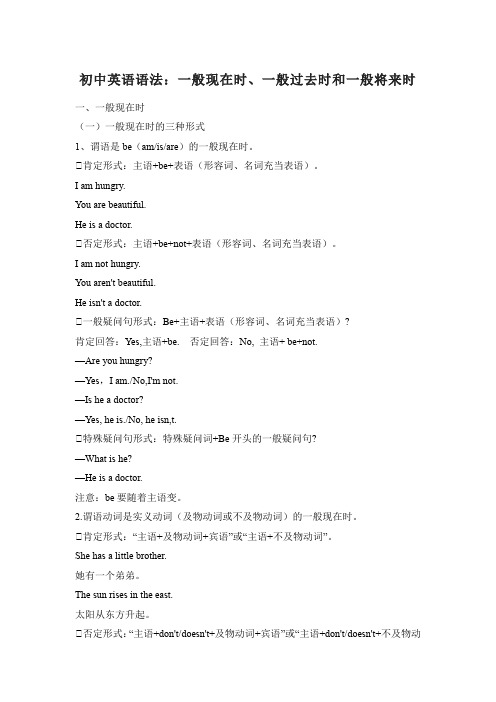
初中英语语法:一般现在时、一般过去时和一般将来时一、一般现在时(一)一般现在时的三种形式1、谓语是be(am/is/are)的一般现在时。
①肯定形式:主语+be+表语(形容词、名词充当表语)。
I am hungry.You are beautiful.He is a doctor.①否定形式:主语+be+not+表语(形容词、名词充当表语)。
I am not hungry.You aren't beautiful.He isn't a doctor.①一般疑问句形式:Be+主语+表语(形容词、名词充当表语)?肯定回答:Yes,主语+be. 否定回答:No, 主语+ be+not.—Are you hungry?—Yes,I am./No,I'm not.—Is he a doctor?—Yes, he is./No, he isn,t.①特殊疑问句形式:特殊疑问词+Be开头的一般疑问句?—What is he?—He is a doctor.注意:be要随着主语变。
2.谓语动词是实义动词(及物动词或不及物动词)的一般现在时。
①肯定形式:“主语+及物动词+宾语”或“主语+不及物动词”。
She has a little brother.她有一个弟弟。
The sun rises in the east.太阳从东方升起。
①否定形式:“主语+don't/doesn't+及物动词+宾语”或“主语+don't/doesn't+不及物动词”。
She doesn't have a little brother.她没有弟弟。
I don't eat every morning.我每天早晨都不吃饭。
①一般疑问句形式:“Do/Does+主语+及物动词原形+宾语”或“Do/Does+主语+不及物动词原形”。
肯定回答:Yes,主语+do/does. 否定回答是:No, 主语+ don't/doesn't.—Do you eat every morning?—Yes, I do./No, I don't.—Does she have a little brother?—Yes, she does./No, she doesn't.①特殊疑问句:特殊疑问词+do/does开头的一般疑问句?What do you like?When do you go to school?注意:根据主语确定用do还是does。
九年级英语常见一般现在时最全总结

【答案】C
【解析】【分析】句意:如果你想取得好成绩,你应该努力学习。根据be supposed to do sth.,应该做某事,固定搭配。主语是you,be要用are,故选C。
【点评】考查固定搭配be supposed to do sth。注意后接不定式形式。
【答案】D
【解析】【分析】第一个空前面有动词is,填doing构成现在进行时,第二个空often是一般现在时的标志,主语he是第三人称单数,动词用三单形式does,故选D。句意是:我弟弟正在做家庭作业。他经常在家里做家庭作业。
【点评】本题考查现在进行时和一般现在时的用法。
2.Millions of people _________ the Great wall every year.
A. dare not to go B. dares not go C. doesn't dare to go D. doesn't dares go
【答案】C
【解析】【分析】句意:晚上她不敢一个人出去。dare可以作情态动词也可以作行为动词,作情态动词时,后面直接跟动词原形,没有人称与数的变化,构成否定时直接在dare后加not,作行为动词时后跟动词不定式,构成否定需要助动词,故答案是C。
A. visited B. visit C. will visit D. are vesting
【答案】B
【解析】【分析】句意:成千万的人每年参观长城。根据every year,可知句子时态为一般现在时,故答案是B。
【点评】考查一般现在时,注意根据时间状语确定句子的时态。
初中英语语法一般现在时全解
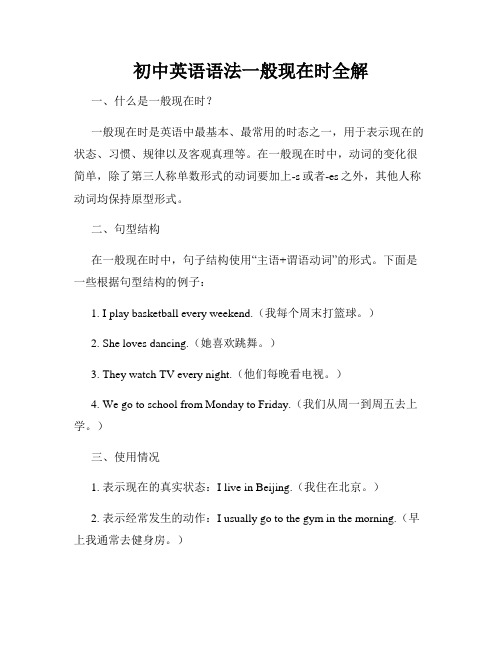
初中英语语法一般现在时全解一、什么是一般现在时?一般现在时是英语中最基本、最常用的时态之一,用于表示现在的状态、习惯、规律以及客观真理等。
在一般现在时中,动词的变化很简单,除了第三人称单数形式的动词要加上-s或者-es之外,其他人称动词均保持原型形式。
二、句型结构在一般现在时中,句子结构使用“主语+谓语动词”的形式。
下面是一些根据句型结构的例子:1. I play basketball every weekend.(我每个周末打篮球。
)2. She loves dancing.(她喜欢跳舞。
)3. They watch TV every night.(他们每晚看电视。
)4. We go to school from Monday to Friday.(我们从周一到周五去上学。
)三、使用情况1. 表示现在的真实状态:I live in Beijing.(我住在北京。
)2. 表示经常发生的动作:I usually go to the gym in the morning.(早上我通常去健身房。
)3. 表示普遍真理或客观规律:The sun rises in the east.(太阳从东方升起。
)4. 表示评论、陈述、想法等:I think English is an interesting subject.(我认为英语是个有趣的科目。
)四、一般现在时的注意事项1. 第三人称单数形式的动词要加上-s或者-es:He reads books every day.(他每天阅读书籍。
)但是要注意规则动词的变化,如do变为does。
2. 否定句需要在谓语动词前加上助动词do或does,并在其后加上not:I do not like coffee.(我不喜欢咖啡。
)She does not listen to music.(她不听音乐。
)3. 疑问句需要将助动词do或does提前至主语之前:Do you play tennis?(你打网球吗?)Does she go to school by bus?(她坐公交车去上学吗?)4. 当主语为第三人称单数时,疑问句直接用助动词does,无需加s:Does he like ice cream?(他喜欢冰淇淋吗?)五、总结一般现在时是英语中最基础、最常用的时态之一,用于表示现在的状态、习惯、规律以及客观真理等。
- 1、下载文档前请自行甄别文档内容的完整性,平台不提供额外的编辑、内容补充、找答案等附加服务。
- 2、"仅部分预览"的文档,不可在线预览部分如存在完整性等问题,可反馈申请退款(可完整预览的文档不适用该条件!)。
- 3、如文档侵犯您的权益,请联系客服反馈,我们会尽快为您处理(人工客服工作时间:9:00-18:30)。
一般现在时讲解和练习一、定义:一般现在时表示经常或习惯性的动作,也可表示现在的状态或主语具备的性格和能力。
例:(1).表示事物或人物的特征、状态。
The sky is blue.天空是蓝色的。
(2).表示经常性或习惯性的动作。
I get up at six every day.我每天六点起床。
(3).表示客观现实。
The earth goes around the sun.地球绕着太阳转。
二、一般现在时常用时间状语、时间副词in the morning/afternoon/eveningevery week (day, year, month…)on Sundays (Monday, Tuesday…)at night, once a week,.always总是, usually通常, often经常, sometimes有时, never从不三、用法:1.肯定句:(1)句中有be(am,is,are)和情态动词时,①be动词时,主语是I时要用am,主语是you时要用are,其他用is。
②是情态动词时,后面的动词用原型③例:I am a student.You are very beautiful.She is my best friend.He can do his homework by himself.(2)没有be(am,is, are)动词和情态动词:主语为第三人称单数(she ,he ,it )、单数可数名词、不可数名词的,动词要按规则加上s或es;主语是复数可数名词的肯定句,动词用原形。
例:①She(He, It )likes fish. 她(他,它)喜欢鱼。
(主语为第三人称单数)②The table has four legs.桌子有四条腿。
(主语为单数可数名词)③Water boils at 100 degrees Celsius.水在100度沸腾。
(主语为不可数名词)They go to school every day .他们每天都去上学。
(主语是复数可数名词的,动词用原形)注意的问题:第三人称单数以及第三人称单数时动词的变化规则在一般现在时中,当主语是第三人称单数时,谓语动词要用第三人称单数形式,即常在动词原形后加-s或-es。
但有些同学们对于哪些主语是第三人称单数还不十分清楚,现归纳总结如下:1、人称代词he, she, it是第三人称单数。
如:He likes watching TV. 他喜欢看电视。
She has lunch at twelve. 她十二点吃午餐。
It looks like a cat. 它看起来像只猫。
2、单个人名、地名或称呼作主语;是第三人称单数。
如:①Han Mei looks like her mother. 韩梅看起来像她的母亲。
②Beijing is in China. 北京在中国。
③Uncle Wang often makes cakes. 王叔叔经常做蛋糕。
3、单数可数名词或"this / that / the+单数可数名词"作主语时,是第三人称单数。
如:①A horse is a useful animal. 马是有用的动物。
②This book is yours. 这本书是你的。
③That car is red. 那辆小汽车是红色的。
④The cat is Lucy's. 这只猫是露茜的。
4、不定代词someone, somebody, nobody, everything, something等及指示代词this, that作主语时,是第三人称单数。
如:①Everyone is here. 大家到齐了。
②There is something wrong with the watch. 这块手表有毛病。
③This is a pen. 这是一支钢笔。
④That is an eraser. 那是一块橡皮擦。
5、不可数名词作主语时为第三人称单数。
如:①The milk is in the glass. 牛奶在玻璃杯里。
②The bread is very small. 那面包很小。
6、当数字或字母作主语时,看作第三人称单数。
如:①"6" is a lucky number. "6"是个吉利数字。
②"I" is a letter. "I"是个字母。
动词+s的变化规则1.一般情况下,直接加-s,如:cook-cooks, make-makesruns gets likes collets takes plays climbs 2.以s. x. sh. ch. o结尾,加-es,如:guess-guesses, wash-washes, watch-watches, go-goes 3.以“辅音字母+y”结尾,变y为i, 再加-es,如:study-studies方法与发音:1.一般情况下,直接加-seg. works,plays, rains, sees2.以sh, ch, s, x 或o 结尾的词后加–eseg. washes, teaches, fixes, does, goes3.以辅音字母加-y 结尾的,先把‘y’ 改成‘i’, 再加-eseg. studies, flies, carries注意: 动词加-s 以后的读音.动词加-s后的读音1.在[p] [t] [k] [f] 等清辅音后,发清辅音/s/eg. helps, works, likes, hates ,laughs2.在浊辅音和元音后,发浊辅音/z/eg. drives, cleans, plays3.在[s] [z] [∫ ] [tʃ] [dʒ]后,发/iz/rises, wishes, teaches, urges4.在[t] [d]后,发/ts/ /dz/eg. fits, sets, needs5. 其他情况下发[z]eg. plans, cries, shows练习1❖1.Jenny _____ in an office. Her parents _____in a hospital.❖ A work; works B works; work C work; are working D is working; work❖2.One of the boys_______ a black hat.❖ A have B there is C there are D has❖3.Wang Mei ______ music and often ______ to music.❖ A like; listen B likes; listens C like; are listening D liking ; listen❖ 4. Jenny______ English every evening.❖ A has study B studies C study D studied❖ 5. The teachers ________(speak) English in class.❖ 6. The teacher ________(speak) English in class.2. 否定句:(1)句中有be动词(am , is , are )或情态动词(may , can , must , should)时,否定句在be动词和情态动词后加not,I am not a teacher. He can not fly .(2) 句中没有be动词(am , is , are )或情态动词(may , can , must , should)时,主语为第三人称单数的否定句,在动词原形前加does + not (doesn’t)。
He doesn’t like cats.(3)句中没有be动词(am , is , are )或情态动词(may , can , must , should)时,主语为复数可数名词的否定句,在动词原形前加do + not (don’t)。
They don’t go to school on Sundays.练习2❖ 1. The cat _________(not like) you.❖ 2.Brian (not live) in China.❖ 3.The picture ______ nice.❖ A. don’t look B. is looked❖ C. doesn’t look D. is looking❖ 4. I have many books.(改为否定句)_________________________❖ 5.厦门不下雪。
__________________________________________❖ 6.她不看新闻。
__________________________________________❖7.我妈妈不喜欢吃肉______________________________________3.疑问句:(1)句中有be动词(am , is , are )或情态动词(may , can , must , should)时,一般疑问句将be动词或情态动词放在句首。
由肯定句变为一般疑问句的步骤:①. 把be 动词(am , is , are )或情态动词(may , can , must , should)提前。
②.大写和小写的转换,句首的第一个字母要大写。
③.句末要加问号。
例:肯定句:She is a student . 疑问句:Is she a student ?肯定句: He can swim. 疑问句:Can he swim? .疑问句的回答:用什么问就用什么来回答。
Is she a student ? Yes, she is . No,she isn’t.Can you swim? Yes, I can . Yes, I can’t.(2) 句中如果没有be动词(am , is , are )或情态动词(may , can , must , should)时,主语为第三人称单数(she ,he ,it )、单数可数名词、不可数名词的疑问句要用does 来提问。
即在句首加does,句子中原有动词用原形例:—Does he like Chinese? 他喜欢汉语吗?—Yes, he does. 是的,他喜欢(汉语)。
—Does a dog eat meat? 狗吃肉吗?—No, it doesn’t. 不,它不吃(肉)。
(3) 句中如果没有be动词(am , is , are )或情态动词(may , can , must , should)时,主语为复数可数名词的疑问句要用do 来提问。
